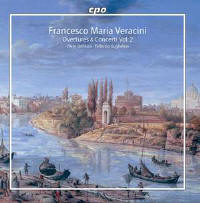Texte paru dans: / Appeared in: |
|
|
Outil de traduction ~ (Très approximatif) |
|
|
Reviewer: Bertil
van Boer
The name of Francesco Veracini
is one that has emerged from history as a renowned violin virtuoso, but also
as one of the most important composers for the instrument of the generation
after Arcangelo Corelli and prior to Pietro Locatelli. A colleague of
Francesco Geminiani, Giuseppe Tartini, and Antonio Vivaldi, likewise
virtuosi, Veracini achieved international fame both for his playing and for
his compositions, which for the violin proved to be seminal in advancing its
technique. By 1714 he had his debut in London, and thereafter toured
northern Europe to great acclaim. His style of playing was probably the most
animated prior to Paganini, and he apparently had an ego to match. He was,
indeed, a difficult person, demanding and prone to a certain capriciousness.
Such was his instability that in 1722 he defenestrated himself in a pique,
breaking his leg. Thereafter, he traveled from place to place, mainly
between Italy and London, alienating practically everyone. A final straw
came when his academic sonatas were performed in the latter city in 1744.
These were deemed so wild and technically demanding that they were not a
success. His last years were spent in Florence, writing theoretical
treatises and functioning as the maestro di cappella for a local church.
His nature, which today we
probably would call narcissistic and bipolar, were inimical to the
sensibilities of his time, but the behavior no doubt contributed to his
music remaining in the repertory, unlike so many of his common orchestral
colleagues. It is, however, their difficulty that makes them worth studying
as part of the technical development of violin playing. Here, the ensemble
L’Arte dell’Arco has chosen to return to Veracini’s music, following an
absence of almost a decade and a half. The two overtures are interesting
suites, probably written in Venice. They do sound a bit Handelian, but the
movements do not precisely conform to the German models that he and his
contemporaries espoused. The first of these opens with a more conventional
French overture, including repetitions of the Largo-Allegro tempos. Here the
faster sections do have a bit of imitation, but the effect is more dancelike
than not. Of course, the opening contains the obligatory dotted French
rhythms. The following movement seems to be more like a Baroque hornpipe,
while the minuet that follows has just a hint of Telemann in the scalar main
theme and sequencing of the line. The Sarabande takes on the tone of a
steady march, and the suite ends with rather lively Allegro that is
thematically reminiscent of the opening, bringing it to a circular close.
The third overture of the manuscript set is perhaps a bit more conventional,
but at the same time more Italian. To be sure, the opening Largo does
emphasize the dotted rhythms characteristic of the French Overture style,
but the succeeding slow movement is more contrapuntal, almost more Corellian.
The air that follows is rather jumpy and quite French, while the next
movement, an Allegro, seems to channel Vivaldi initially, but with the
ritornellos leaning heavily towards Handel. The Sarabande has three hammer
strokes, but is texturally more homophonic, while the triple meter Gigue has
some internal portions that are imitative. As suites, these two are nice if
quite conventional examples of a common genre. Where Veracini shines is in the D-Major Violin Concerto, here in a more modern three-movement format. The opening movement has a Vivaldian mood, and the solo part swirls about, scurrying all over the fingerboard in sequential roulades. A double-stop theme in the solo marks the slow movement, and here one can see Veracini’s ability to write in chords. The final Presto is like a whirling dervish in its non-stop running line, challenging to the soloist to say the very least. The two sonatas, by comparison, return to the sonata da camera model in which the movements are stylized dances. The C-Major Sonata’s second movement, for example, has the technical challenges of the concerto, but the slow movements are rather more operatic, with slowly unfolding melody lines that include some ancillary virtuosity that reinforces the languid themes, almost vocal arias transferred to the violin.
The
performances by L’arte dell’arco are quite nice. The tempos chosen by
Frederico Guglielmo all fit the music well, and the addition of the oboes
and bassoons in the two overtures allows for a fuller texture, not to
mention contrasting timbres. Guglielmo’s violin performance is clear, his
technique brilliant. My only quibble is that the recording sound is a bit
transparent, especially in the overtures, which sometimes makes it sound a
bit tinny. Veracini, for whatever personal foibles he had, can be seen as a
professional if not too exciting composer. The emphasis upon violin
virtuosity can be taken as granted, and it is quite impressive, but the
accompaniments and instrumental numbers tend to be a bit staid, even as they
diverge from the standard models of the time. On the one hand, it is good to
have these pieces, as they mark a long-anticipated continuation of the
revival of Veracini’s music, and there is no question that the virtuoso
parts are striking. On the other, there seems to be a conventionality of the
works that the ensemble can mitigate but not overcome. In short, it is a
good disc with good playing, but the music will hardly rise to the
exceptional. Get it for your library, but don’t have the expectation that
this will be revelatory. | |
|
|
|
|
Cliquez l'un ou l'autre
bouton pour découvrir bien d'autres critiques de CD |
|




